 Coprinopsis - click to expand
Coprinopsis - click to expandMicroscopically, the pileipellis is a cutis, which means the top layer of the
cap has strings of cells laying flat. To the naked eye, they often have shaggy
veil material on the cap, but not always, and so do some other genera
occasionally. The caps are often greyish, and they usually completely
deliquesce. The sizes can range from miniscule to very large (caps 1 mm to
10 cm). Not all Coprinopsis turn to ink. Some former
Psathyrellas that do not deliquesce may be recognized by their relatively stocky stature and
large spores >10u across.
Species mentioned: Coprinopsis atramentaria,
atramentaria var. crassivelata, depressiceps, striata, pinguispora,
acuminata, romagnesiana, strossmayeri, picacea, lagopus, lagopides, marcida, brunneistragulata,
jonesii, pachyderma, cinerea, fimetarius, friesii, nivea, pseudonivea, stercorea, tetraspora, subdomestica, undulata, sylvicola, kubickae, phaeospora,
psychromorbida, uliginicola, canoceps, marcescibilis. Psathyrella longipes, fragilissima, elwhaensis,
huronensis. Coprinus alnivorus.
Alcohol Inkies - If you are still digesting any of these with
alcohol present in your blood stream, you will probably get very sick. In other
words, even taken 24-48 hours apart there might be a chance of poisoning.
Coprinopsis atramentaria
EU
(=Coprinopsis depressiceps WA?) - The alcohol inkies
contain coprine, a substance with similar effects as disulfram (the active
ingredient in antabuse) that make you quite sick if ingested when you have also
ingested alcohol. C. atramentaria is the most famous alcohol inky cap, with a large, grey-brown cap with a
broad or depressed cap apex (not narrow and/or umbonate like Coprinopsis
striata, described next). The cap and lower stem may be bald or have brown scales,
but they are different than the orange-brown concentric scales of C.
romagnesiana, below, which has a scalier stem too. Fred Van de Bogart described
local collections with a
depressed cap centre and a slightly different shape of spore as Coprinopsis depressiceps,
and reported both species locally. The ITS type sequence of C. depressiceps is
about 6 bp different from many EU sequences of Coprinopsis atramentaria,
but Wachter showed that throughout Europe and the world you can find that ITS
can vary by that amount within C. atramentaria, so perhaps they are
synonyms. It should be further investigated to make sure.
Coprinopsis striata
- Alcohol inky (=Coprinopsis pinguispora WA) - Very similar alcohol inky, but with a narrower and/or pointier cap
and not quite as large. It is practically smooth with even fewer visible
scales. Our local
species was described by Fred from WA, and most sequences from OR, WA and BC
of the "atramentaria group" are this species, so it appears to be our
most common species by far. Fred also described Coprinopsis pinguispora a few pages
later, but its type sequence is the same, so it is probably not a distinct
species. It only differed by not having striations on the cap, which is probably
a variable feature.
Coprinopsis acuminata
EU
- a sister species, with more "normal" shaped spores than C. striata,
that Fred also reported
from the PNW, so it's possible it is here too and should be looked for.
Coprinopsis romagnesiana
WA
- Alcohol inky - This alcohol
inky has coloured, orange-brown scales, concentrically arranged as the
cap expands (unlike in C. atramentaria), with the scales built in to the
cap so that they can't
be washed off. The stem is usually scaly. Unfortunately, it has been
found with very subtle scaling. It's an EU species that has been found
and sequenced in WA three times now.
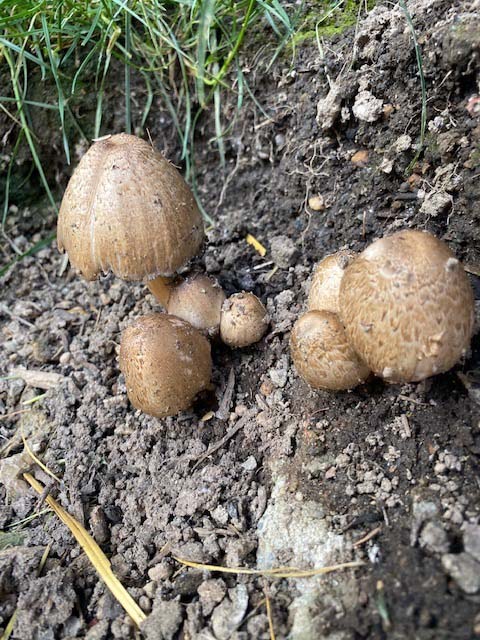
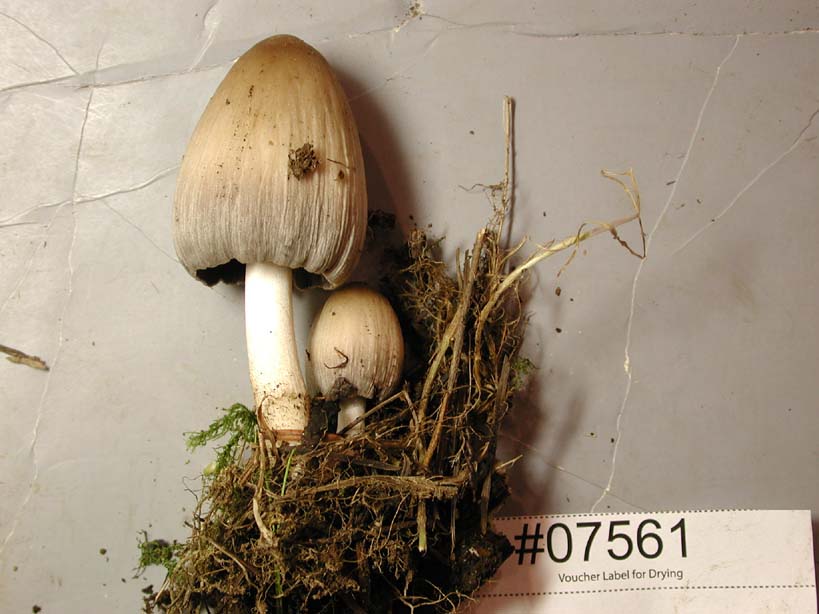


Coprinopsis atramentaria © Keifer Chalk, Coprinopsis striata © NAMA and the Field Museum of Natural History,
C. romagnesiana © Daniel Winkler and Danny Miller
Non-Alcohol
Inkies - as far as is understood, the rest can be consumed with alcohol.
Coprinopsis
variegata NY (=C. strossmayeri EU, =C. 'variegata IN01')
-
Another largish, grey, clustered, narrow capped species (like C. striata)
but with a cap covered in whitish (or apparently yellowish) universal scale patches that can
wash off the cap and with thick
orange-brown rhizomorphs that smell mouldy. The European species has variable ITS
DNA that varies by about 2.5% in Europe, but so far it's all considered one
species. A couple of east coast sequences that might be C. variegata fall
in this complex. C. variegata is the oldest name and probably the correct
name for this species but until we prove it with type sequences and multiple
genes, some give it the code C. "variegata'IN01" for now. This species complex was not known in the PNW until one poisoning report in BC
where the mushroom they ate was sequenced and turned out to be somewhere in this
complex (but not matching the east coast C. variegata exactly).
Interestingly, it is not considered poisonous, even with alcohol, as it is not in the same clade as
the alcohol inkies.
Coprinopsis atramentaria var. crassivelata WA -
this is likely either the same as C. variegata or the same as the alcohol
inky C. romagnesiana (we do not have the type sequence). Fred
did not note either of those species for the PNW, but did describe this variety,
which is probably one of those two (the other probably not having been noticed by him). At first I
thought it was C. romagnesiana as that is closely related to C.
atramentaria and found in WA. But Fred's description is of universal veil
material that can wash off, which may be more like C. variegata. The spore sizes more closely matches C.
variegata as well. This name would be a newer synonym no matter which it was. If it turns out that our C.
variegata needs a new name, this
may provide one, but it will need promoting to species.


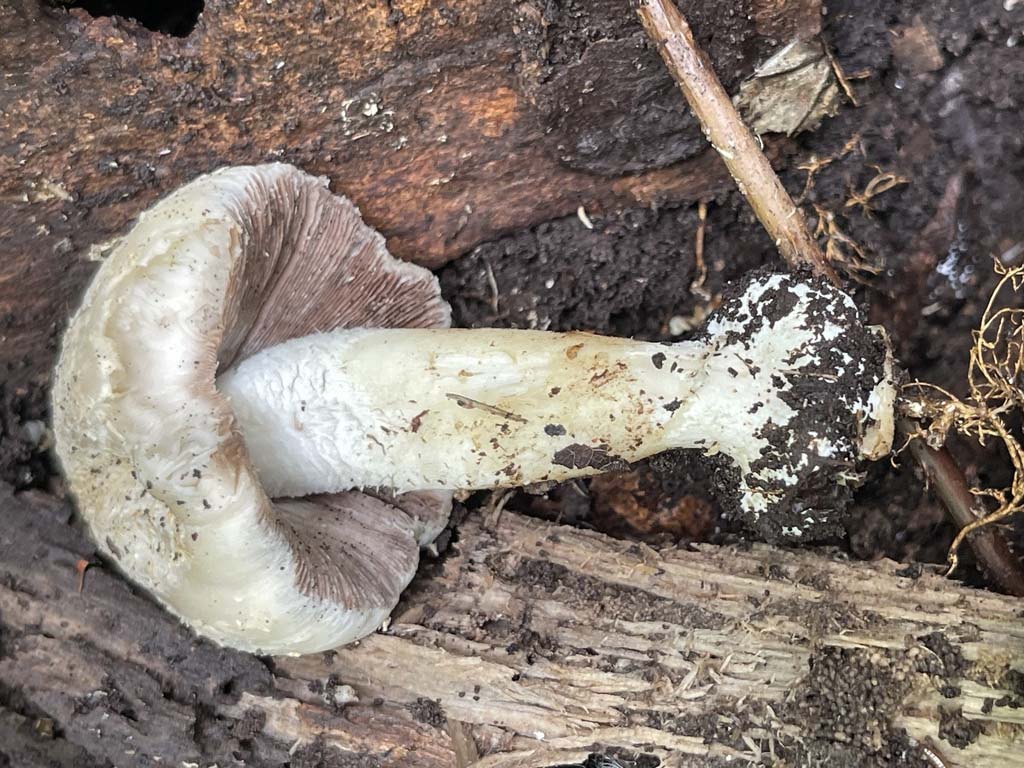
Coprinopsis variegata © Cin Thomas (3 images)
Coprinopsis
picacea EU - A large, spectacularly mottled inky cap, with large,
off white removable scales. Quite famous and common elsewhere in the world, but
never reported here until found and sequenced recently in OR.
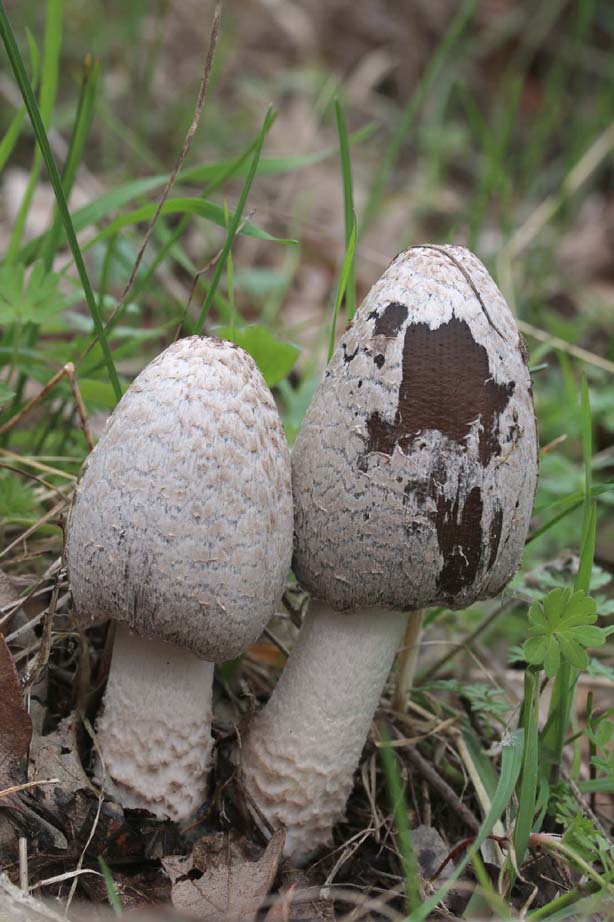
Coprinopsis picacea © Jonathan Frank
Coprinopsis lagopus EU group - These
medium sized grey mushrooms, covered in shaggy white veil material, deliquesce
in a matter of hours and are very short lived. They are so abundant,
though, that they are still easy to find, even though any individual mushroom
may not be around for longer than four hours or so (from sprouting to
dissolving).
Coprinopsis 'lagopus
PNW06' (Wachter F, Nagy PS2) - there are seven genetic species that might be C.
lagopus (numbered A through G by Wachter whose paper I reference on my Psathyrella
page, and numbered 1 through 6 by Nagy). Two recent collections that have been
sequenced (from Vancouver BC and Bridle Trails) were Coprinopsis lagopus F
Wachter
(Nagy's species #2). Perhaps that is our abundant species, but we need
a lot more collections to find out which species occur here and their
relative commonality.
Coprinopsis lagopides EU - reported from the PNW
but we don't have a reliable type area sequence to know what this really is. If
you think you find one, save it.
Coprinopsis lagopides
var. trisporus WA - Fred Van de Bogart described this from WA but we
don't have the type sequence or any other collections to know what it is and how
it differs from the type variety. If you think you find one, save it.
Coprinopsis marcida MT - known only from the type sequence from Montana
plus one Oregon and one WA collection that match within 4 bp.
Coprinopsis
brunneistragulata WA/jonesii VT -these two species have basically the
same ITS sequence. Various collections of C. jonesii sequence within
0.5%-1% of each other and the type sequence from WA of C. brunneistrangulata
is in that clade. However, Wachter did not synonymize them because C.
brunneistrangulata is the only species in this group with a perisporium
in the spores (and it also was not found in a burned area like C.
jonesii usually is). One recent collection in this clade was found in a
burn.
Coprinopsis pachyderma WA -
we have the type sequence.
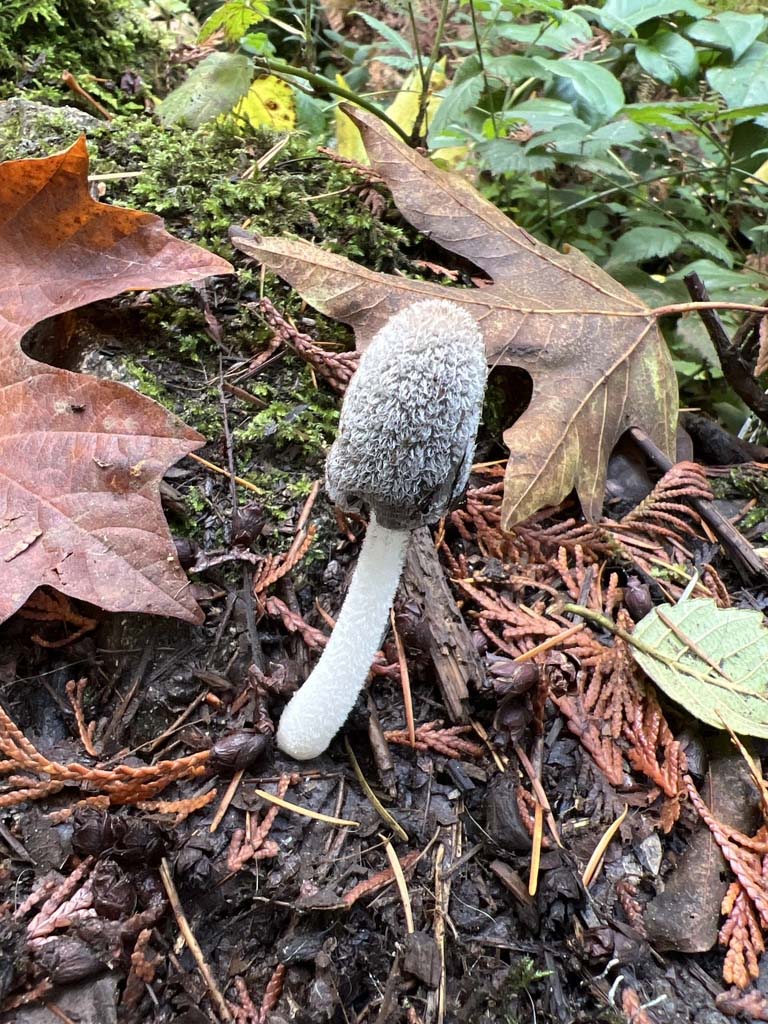
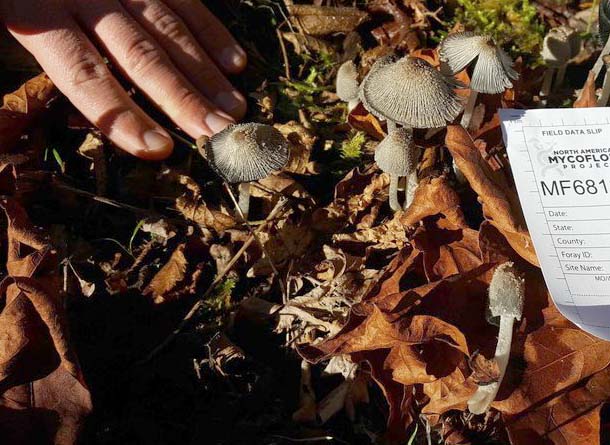
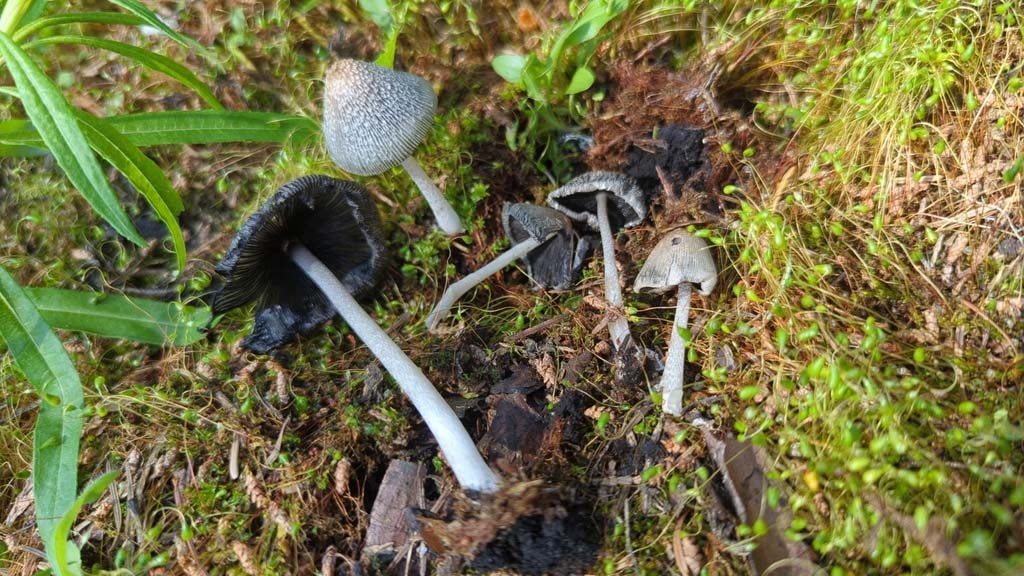
Coprinopsis 'lagopus PNW06' © Ann McCall, Coprinopsis marcida © Bruce Newhouse, Coprinopsis
jonesii © Alan Rockefeller
Coprinopsis cinerea EU (=Coprinus fimetaria
EU)
- Both
Coprinopsis cinerea and Coprinopsis fimetarius are reported from the
PNW, but they are now thought to be the same thing. C. cinerea is a short lived
lookalike of C. lagopus but it grows on compost and dung and other very
rich or decayed material. We have no local DNA to prove its presence here yet;
we need collections.
Coprinopsis cinerea var. depressa WA
- Not yet officially moved to Coprinopsis, this is a locally
described (from WA) variety that differs by the shape of the spores. It
definitely occurs here, but we don't have a type sequence to know what it is, or
if it is just a variety or a valid species of its own.
Coprinopsis
cf friesii EU - A
small purplish-grey
grass coprinoid with floccose veil material on the cap, that unlike
the C. lagopus group, tatters more than it deliquesces. We have neither reliable EU sequences nor local sequences
to know if that's what we have.
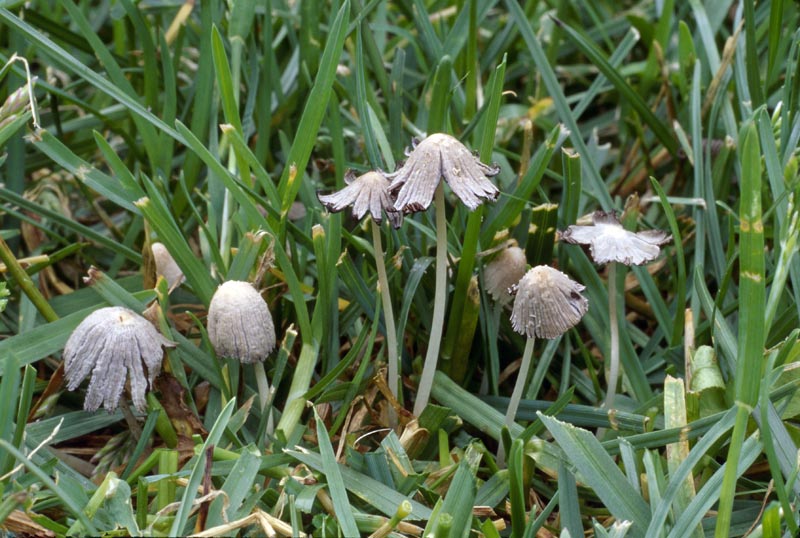
Coprinopsis friesii © Steve Trudell
Coprinopsis subdomestica FL -
This mushroom is kind of a cross between Coprinopsis lagopus and
Coprinellus flocculosus, with a warm brown and grey cap covered in
thick veil material. It was not known from the PNW until sequenced in OR,
matching the type sequence.
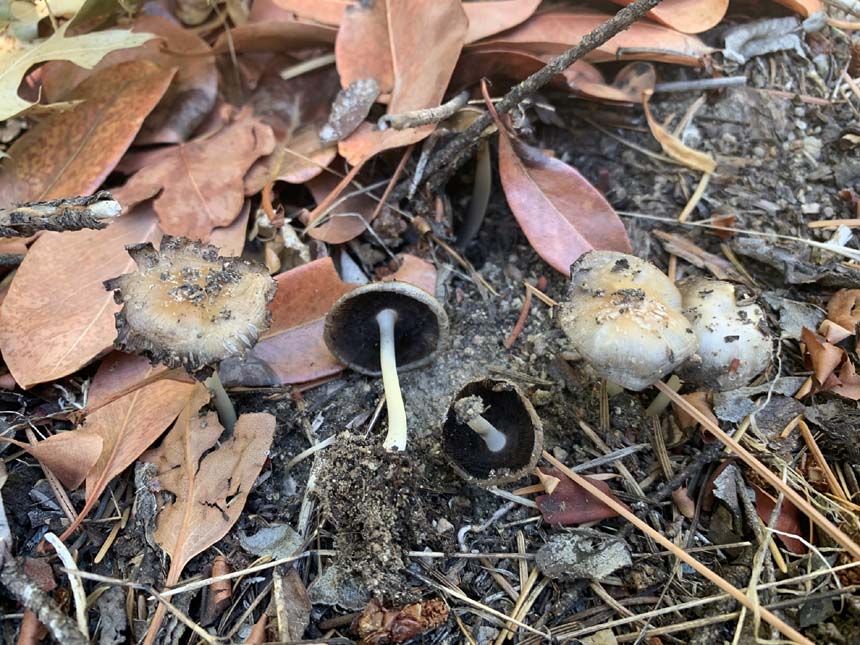
Coprinopsis subdomestica © Jonathan Frank
Coprinopsis nivea EU - This
small to medium (<2.5 cm) sized white inky grows on dung. It
has a bit variable ITS DNA (differing by a few positions even in the EU) also found in the PNW.
Coprinopsis pseudonivea EU
- not known from the PNW until a BC collection showed up. It is very similar but
with smaller spores. Our very young collection seemed especially
shaggy/warty.
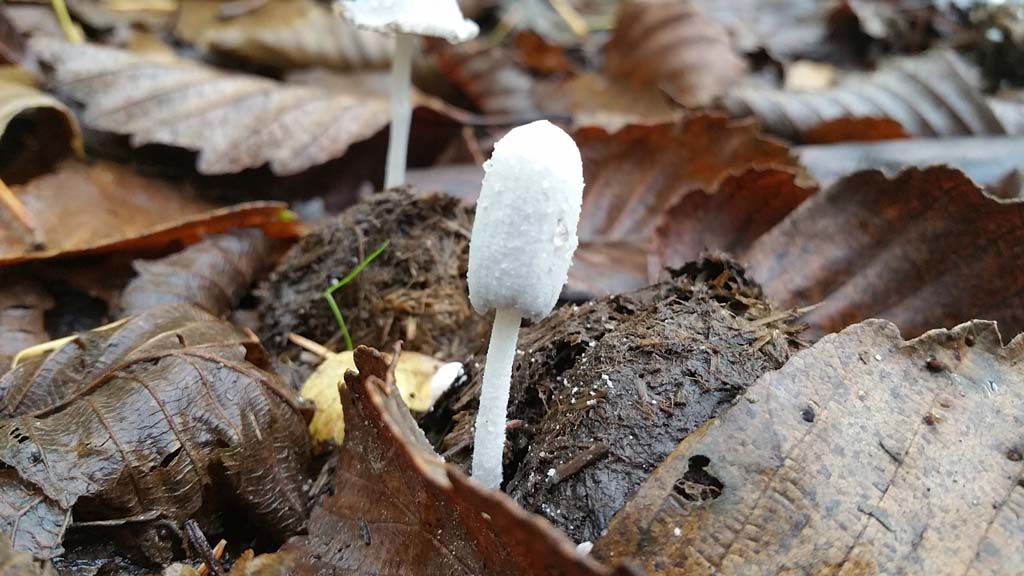


Coprinopsis nivea © Julie Jones, C. pseudonivea ©
Anne Polyakov
Coprinopsis cf
stercorea EU - This miniscule (>=3 mm) white species may be what we find locally on
dung, but we need a local sequence to find out if that's what our species is or
if it's something else.

Coprinopsis cf stercorea © Danny Miller
Coprinopsis PNW05 - the first
collection were tiny
pale grey to pale tan fruitbodies on the cut edge of a trunk
in WA.
The second collection were larger and found on soil. It could be the same as one of the little known named species whose DNA is not
yet known.
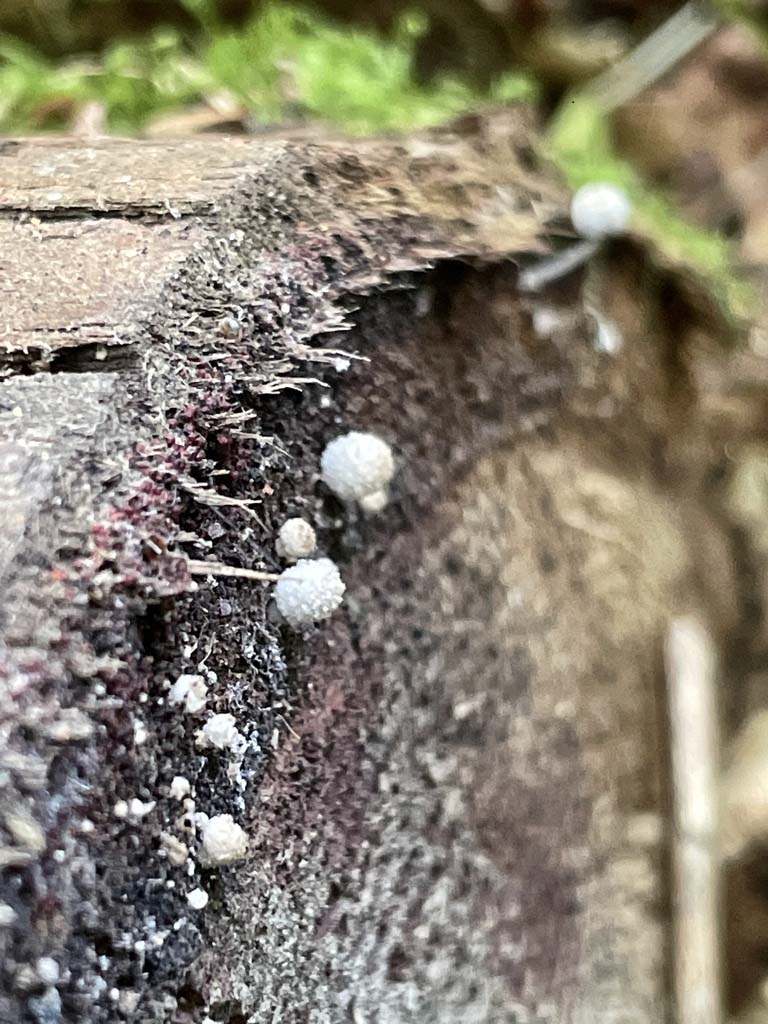
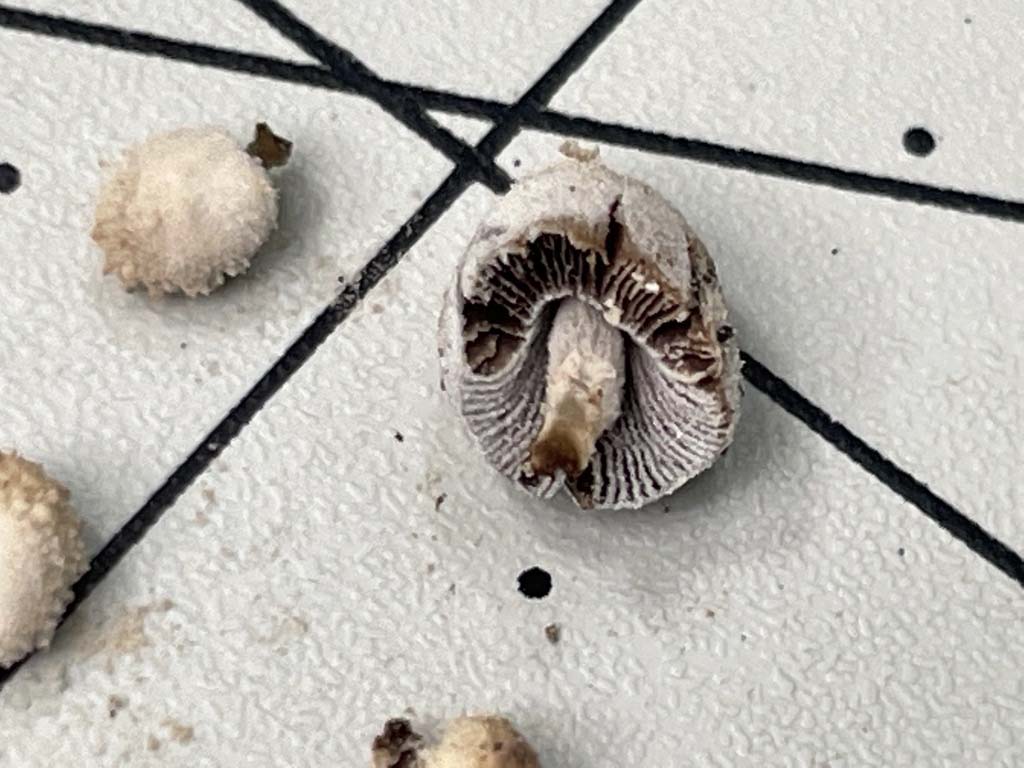

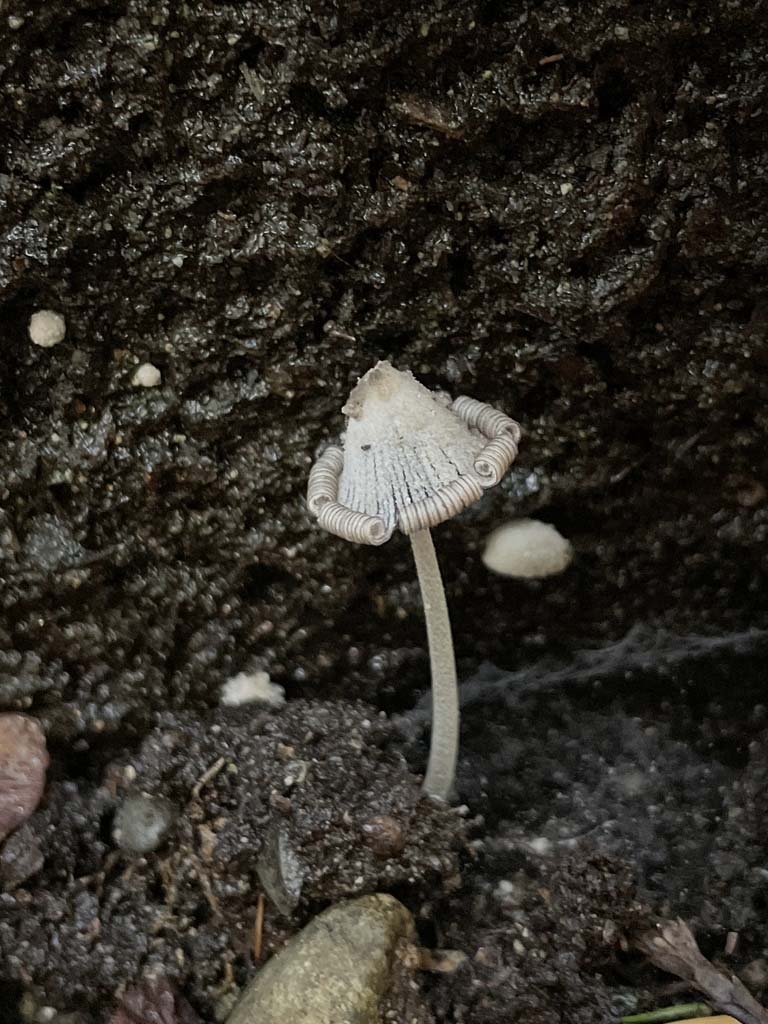
Coprinopsis PNW05 © Yi-Min Wang
Coprinopsis tectispora
WA
- Described from
WA from a greenhouse, this smallish (1-2 cm) pale grey species (covered in
shaggy veil material) has never been photographed in colour, so we need photos
to understand it better. We have the type sequence.
Coprinopsis alnivora WA
- This is one of the only species that was not recombined
correctly by Scott Redhead et. al. when Coprinus was split into
Parasola, Coprinellus and Coprinopsis, but it was subsequently
recombined. It has a ring (it is a
small, pale species on wood) and that was thought to be an
indication of a true Coprinus, but the more important features don't
match (it doesn't have a thread running through the stem and it does have
pleurocystidia). We have the WA type sequence, but it's never been found here
since. Interestingly, it has been found several times in Eurasia.
Coprinopsis undulata WA - we
have the type sequence, but no modern collections nor a photograph. C. undulata
is said to be a compost species with thin white veil material on the cap that
doesn't come off as easily by itself as some other species.
Coprinopsis sylvicola OR
- a forest species said to have red-brown instead of white universal veil material
when examined carefully, but perhaps best recognized microscopically. We have
the OR ITS2 type sequence and now a recent WA collection with the whole ITS
sequence and a photograph.

Coprinopsis sylvicola © Yi-Min Wang
Coprinopsis cf. kubickae EU/cf. phaeospora
EU/cf. psychromorbida EU
-
Small whitish species (<1 cm or even <5 mm) on vegetation, with
subtle brownish scales. These species were reported from the PNW, but no collections have been
sequenced (or even photographed), so we need some collections to find out if we really do have them
here. We have EU sequences of the first, but there are no reliable sequences of
the other two yet to compare to.
Coprinopsis lilacina Sri Lanka (=Coprinopsis
clastophylla TX) - rarely, if ever, seen to fruit as a "normal"
mushroom, this is almost always found in an asexual stage as miniscule pink inky caps with sclerotia for gills
growing on wood. One OR find were simply sclerotia growing on the
ground that came back with this sequence, but this is still a mystery and
this find needs to be verified.


Coprinopsis lilacina © Maddox Atagi
Species that never deliquesce:
Psathyrella longipes
CA -large, but not
terribly stocky, with a smooth, solid brown cap and hanging veil
remnants when young. Spores 10-13 x 7-10u. The unusually large spores >10u across was the first clue
that they belonged in Coprinopsis instead of Psathyrella, where it
still is now. We don't have the type sequence, but I have a handful of matching
sequences from CA probably representing this species. It has also been sequenced
from OR and WA.
Coprinopsis
marcescibilis EU (=Psathyrella fragilissima OR, =Psathyrella elwhaensis WA)
- with somewhat different spores, 12-15 x 6-8.5u. Psathyrella fragilissima
has long been thought to be a newer synonym of C. marcescibilis. There
are 3-5 bp differences between them, but even in the EU ITS can vary a bit, and
my trees do not show support for separating the species. P. elwhaensis is
differentiated by a slightly different shape of spore, but Smith's drawings of
the two species' spores looked identical to me. The only other difference is
that P. elwhaensis is said to never retain any veil material on the cap
disc. P. elwhaensis is said to be much, much more common than P.
fragilissima, yet we have many sequences of the supposedly rare P.
fragilissima and no different sequences that might represent the supposedly
common P. elwahensis. Therefore, I'm pretty sure that P. elwhaensis
is not a distinct species.
Psathyrella huronensis MI
- this has smaller spores than the others, 8-11 x
5-6u, so you might not recognize it as Coprinopsis (in fact it still
needs moving to Coprinopsis from Psathyrella), as the spores barely
exceed 10u. In one collection the average spore length was just 10.3u. It has a
pale cap even when young (the others will get paler s they dry out). One EU sequence is 4 bp different than our one WA sequence.
We don't have a type sequence, but an OH sequence matches ours and suggests we
are using the correct name out here.

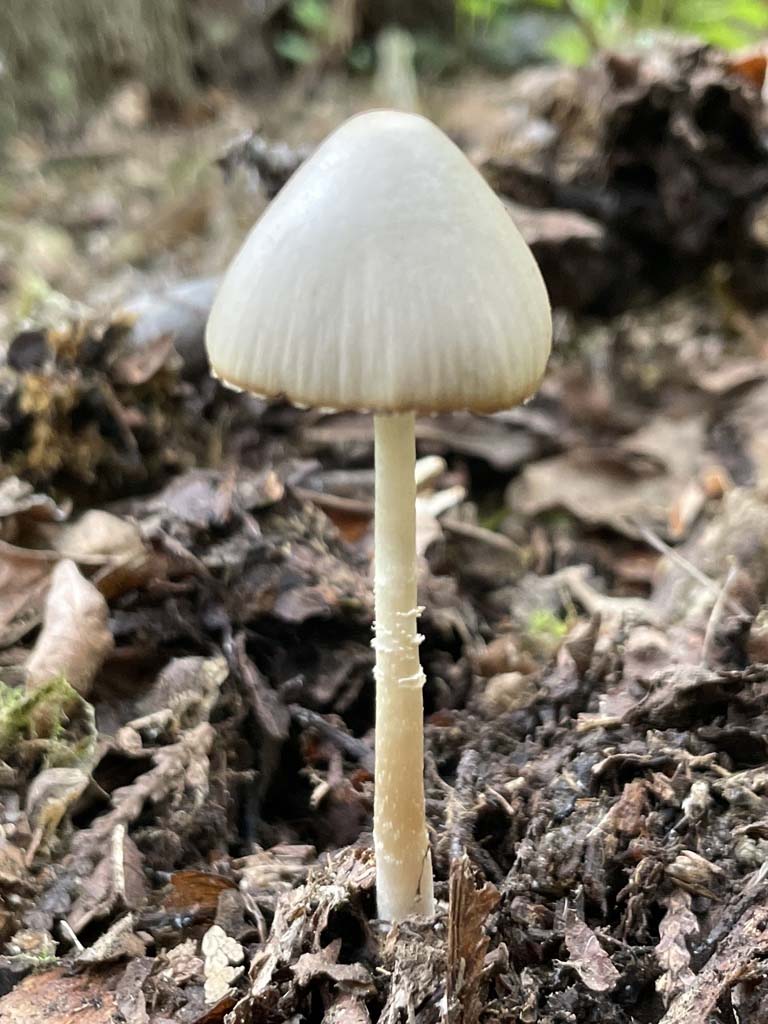
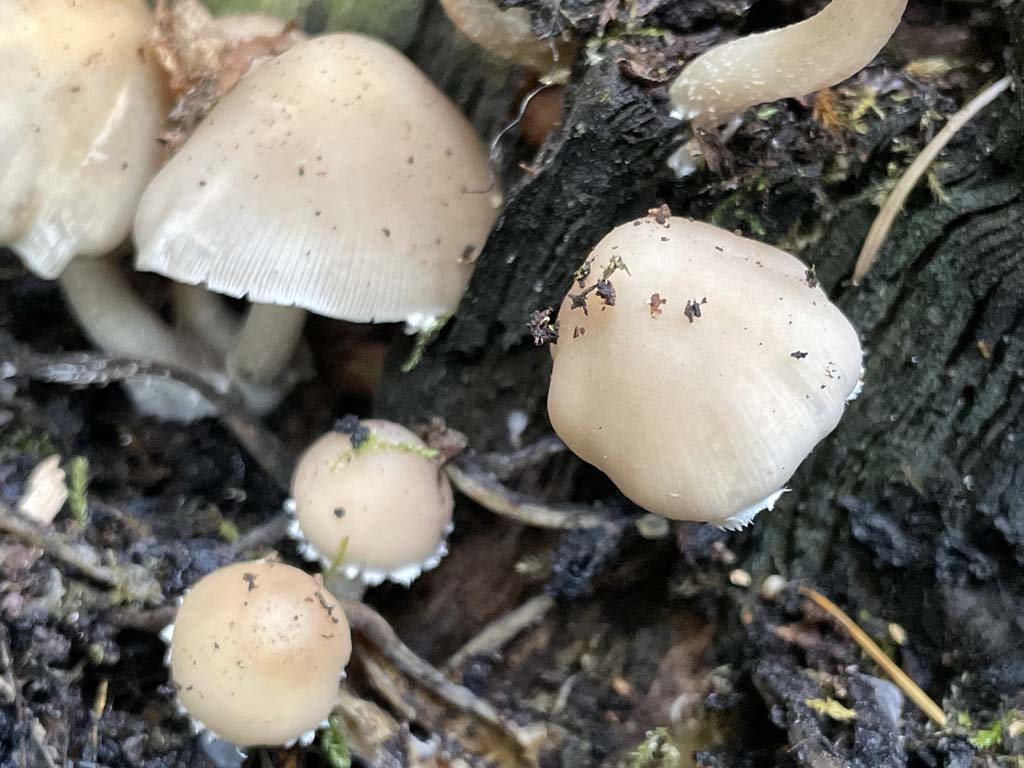
'Coprinopsis' longipes from California © Joanne Schwartz,
C. marcescibilis © Yi-Min Wang, 'Coprinopsis' huronensis © Yi-Min Wang
Coprinopsis uliginicola WY - quite stocky, silky white fibrils on the cap.
We have the type sequence and three local sequences that match each other but
differ from the type by 3 bp near the end, which tells me that the type sequence
is probably dirty and incorrect at the end. California has a sister species.
Psathyrella subagraria NY
-
is likely a
Coprinopsis,
probably another sister species of
C. uliginicola, if not the same thing. It is said to
have pleurocystidia while
C. uliginicola
does not.
Coprinopsis canoceps OR - white cap and stem veil fibrils with a pale brownish grey
cap, like many Psathyrellas. The spores are not as large as
other Coprinopsis, so it took DNA to show where this belonged. We don't have the OR type sequence,
but we have some reliable recent local sequences from WA and CA. Europe may have 2 sister
species to our true species.
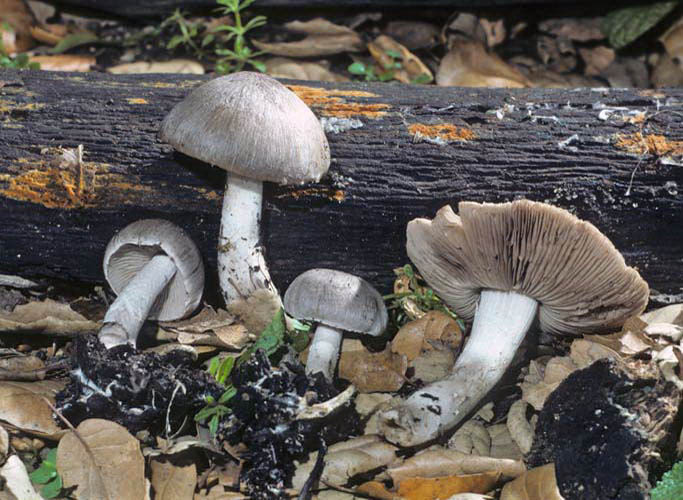
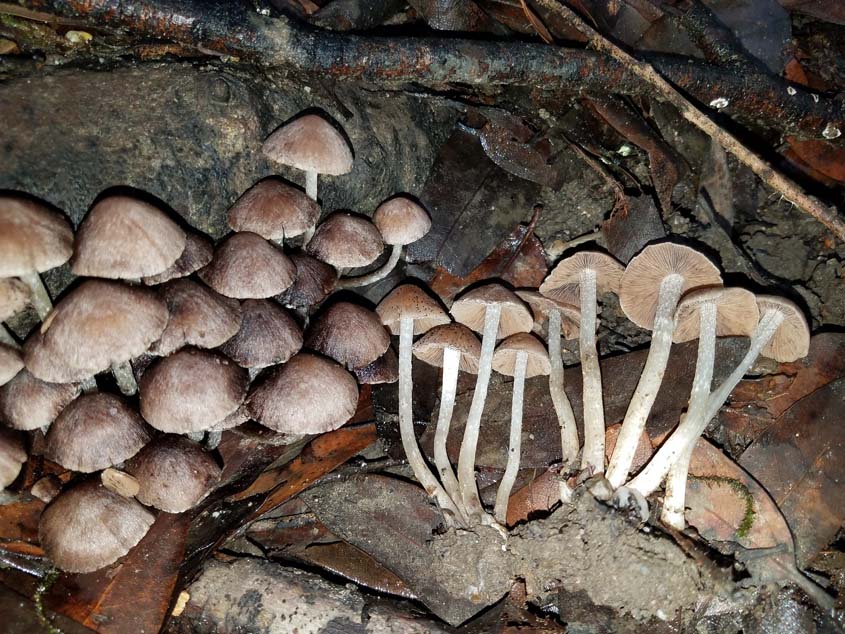
Coprinopsis uliginicola © Kit Scates Barnhart,
Coprinopsis canoceps © Alan
Rockefeller
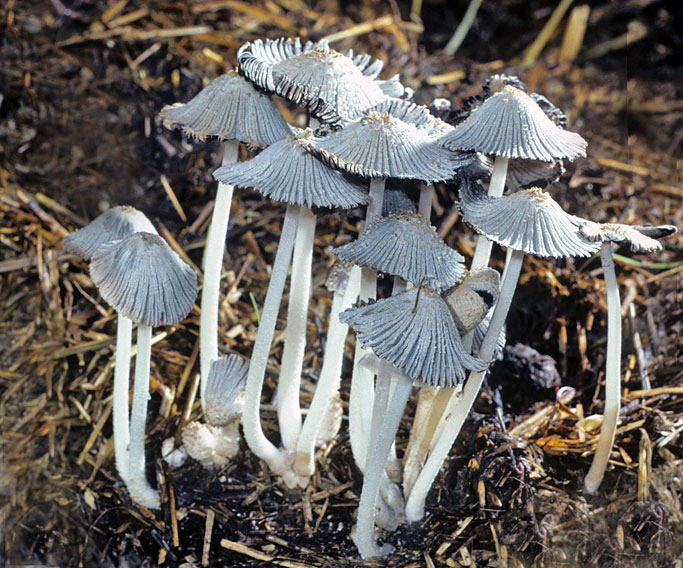
 Parasola - click to expand
Parasola - click to expand
 Coprinellus - click to expand
Coprinellus - click to expand
 Ephemerocybe (Tulosesus) - click to expand
Ephemerocybe (Tulosesus) - click to expand
 Coprinopsis - click to expand
Coprinopsis - click to expand Narcissea - click to expand
Narcissea - click to expand